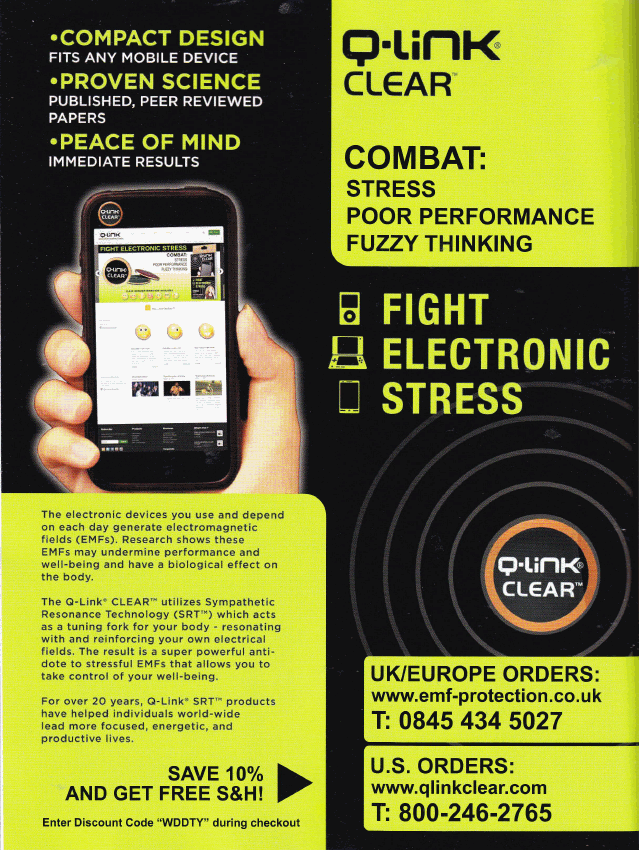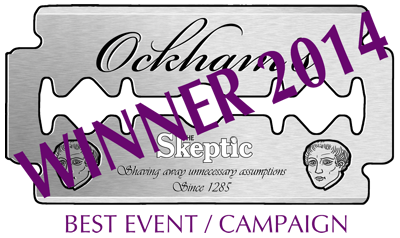WDDTY #6 - The Missing Link?
Another informally resolved case to add to the ever-growing list
 Q-Link Clear
Q-Link Clear
Combat stress, poor performance and fuzzy thinking; fight electronic stress. Proven science; published peer reviewed papers. Peace of mind; immediate results.
Electromagnetic fields from electronic devices can, apparently, undermine performance and well-being and have a biological effect on the body.
So any device that protects us from these must be a good idea, whether it uses 'Sympathetic Resonance Technology (SRT™)' or not. The missing link in our hectic lives?
This is yet another ad placed in both the September and October issues of What Doctors Don't Tell You that we submitted to the Advertising Standards Authority. The advertiser is Clarus, based in California (but whose products are available all over the world) advertising their Q-link Clear,
Their website claims:
The Q-Link CLEAR is a new and exciting addition to the well-known Q-Link range of "body" products. Programmed with over 100 natural frequencies known to support the biofield, the Q-Link CLEAR is compact and feather-light so it won't get in the way. Just attach it to a device where it will come closest to your body. Then, when you use your mobile phone, or listen to music on an mp3 player, hold your game player or otherwise - the Q-Link CLEAR focuses and strengthens the biofield's ability to support your body's natural defenses to EMFs and other stressors.
According to their website, SRT™ is:
Sympathetic Resonance Technology™ (SRT™) is based on the fundamental scientific discovery that every physical system has fields of energy that permeate and surround that system. When systems vibrate at their optimal frequency spectrums, they are able to function more efficiently and deliver expected, even enhanced, levels of performance. When these systems are not vibrating ideally, reduced efficiency and performance can result. In humans, the principal energy system is sometimes referred to as the “Biofield” – a term recognized by the U.S. National Institutes of Health.
SRT™ is an array of proprietarily identified frequencies that support and enhance the efficiency and performance of various organic and inorganic systems. Biological, electrical, chemical and other physical systems influenced by SRT™ applications exhibit increased functionality, coherence, structural integrity and other positive characteristics and benefits
And their trade mark for SRT™ appears genuine, covering:
Treatment of materials by application of electromagnetic energy in the nature of subtle energy frequencies in order to reduce quantum noise and increase the efficiency of energy exchange for the purpose of improving the functioning or extending the useful life of the materials.
So now we know.
But for an alternative view on SRT™ technology and what's in a q-link pendant — which uses the same SRT™ technology — read Ben Goldacre's The Amazing Qlink Science Pedant.
Their ad claimed that it was 'proven science' and there was 'published peer reviewed papers' and their website claims SRT™ has 'proven its effectiveness in a wide range of experiments, including trials at UC Irvine, University of Vienna, and Imperial College London'. However, for some reason, they agreed with the ASA not to repeat efficacy claims until they have sufficient evidence to comply with the CAP Code and assured the ASA that the ad would be withdrawn and amended.
This empathises that holding evidence just isn't enough; it has to be evidence that meets the requirements laid down in the ASA's guidance on substantiation.
Because it was informally resolved, Clarus gets their name published on the ASA's website today as an informally resolved case.
If they had chosen to try to substantiate their claims, the ASA might have formally investigated and examined their evidence — I wonder what that would have found?
Counting
 Still an impressive 35 CAP Code breaches from just five adjudications plus eleven informally resolved cases — with many more to come.
Still an impressive 35 CAP Code breaches from just five adjudications plus eleven informally resolved cases — with many more to come.
Programmer
Thanks to all who offered their services and we'll be in touch with everyone shortly.
23 January 2013
Latest news
- "Undisputable evidence of scientific misconduct" by homeopaths
- Yet another bad year for homeopathy
- Nelsons Homeopathic Pharmacy #3
- Nelsons Homeopathic Pharmacy #2
- The Society of Homeopaths: failing to make the case for homeopathy
- The end of homeopathy on the NHS in Bristol?
- NHS Homeopathy: 20 years of decline
- The different faces of the Society of Homeopaths
- The growing pains of osteopaths
- Diluting misleading claims - ASA update
Most read
- Finding deleted and changed webpages
- About The Nightingale Collaboration
- How to find out who owns a website
- Advertising Standards Authority
- Rubbing salts into the wounds of homeopathy
- How to submit a complaint to the ASA
- The decline of homeopathy on the NHS
- Landmark decisions for homeopaths
- NHS Lanarkshire to end referrals to Glasgow Homeopathic Hospital
- Making a complaint

